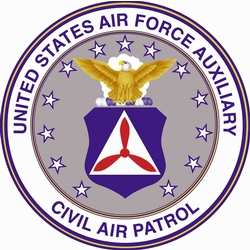Moving Planes, Helping At The EOC
 The Civil Air Patrol mobilized its
aircraft and personnel to prepare for Hurricane Frances over the
weekend, moving aircraft equipped with satellite-transmitted
digital imaging systems (SDIS) to "safe haven" locations as close
as possible to the hurricane’s expected path. CAP members
will use the SDIS systems to capture and transmit aerial photos of
affected sites.
The Civil Air Patrol mobilized its
aircraft and personnel to prepare for Hurricane Frances over the
weekend, moving aircraft equipped with satellite-transmitted
digital imaging systems (SDIS) to "safe haven" locations as close
as possible to the hurricane’s expected path. CAP members
will use the SDIS systems to capture and transmit aerial photos of
affected sites.
"CAP’s aerial imagery proved to be valuable in the
aftermath of Hurricane Charley," said Maj. Gen. Dwight Wheless, CAP
national commander. "Florida’s emergency operations agencies
want to have this resource available again."
Using SDIS, CAP members can capture aerial images from the air
with a digital camera, and quickly transmit the images via e-mail
and a satellite phone. The transmission can occur in near
real-time, allowing emergency operations centers to better plan
assistance for disaster victims and assess property damage.
CAP has personnel from the Florida Wing onsite at the Florida
State Emergency Operations Center in Tallahassee (FL) and expected
to activate more than 100 members for work on aerial and ground
missions during the coming weeks.
CAP members, all of whom are volunteers, are now available to
transport key officials and health care supplies to support
emergency response agencies. According to CAP Southeast Region
Commander Col. Matt Sharkey, CAP ground teams also are likely to be
deployed to find emergency locator transmitters that may be
activated on hangared aircraft or docked boats that sustain damage
in the storm.
"During Charley, more than 700 of these transmitters were
activated on boats and planes that were damaged by the storm,"
Sharkey said. "It was important to locate and deactivate these
transmitters so emergency officials could differentiate genuine
distress signals."
 CAP coordinated the transfer of
aircraft, vehicles and personnel for hurricane missions through its
National Operations Center at Maxwell AFB (AL). As the civilian
auxiliary of the US Air Force, CAP is operating under the direction
of the Air Force National Security Emergency Preparedness Office,
US Northern Command and 1st Air Force.
CAP coordinated the transfer of
aircraft, vehicles and personnel for hurricane missions through its
National Operations Center at Maxwell AFB (AL). As the civilian
auxiliary of the US Air Force, CAP is operating under the direction
of the Air Force National Security Emergency Preparedness Office,
US Northern Command and 1st Air Force.
"CAP can provide SDIS services at a relatively low cost to
emergency agencies," Wheless said. "One reason is that our members
are all volunteers who contribute their own time and resources to
train and stand ready for such operations. Our people sacrifice
time at home and work to perform these missions, often traveling
considerable distances to be available when needed."
Also standing by to help hurricane victims is the CAP Chaplain
Service, which includes members trained in critical incident stress
management. CAP chaplains will be available to guide hurricane
victims to sources of emotional and physical support," said Col.
Charles Sharp, chief of the CAP Chaplain Service. "This is a
particularly difficult situation for those who are still reeling
from the effects of Hurricane Charley. We want people to know they
have places to turn for help."
 ANN's Daily Aero-Linx (04.17.24)
ANN's Daily Aero-Linx (04.17.24) ANN's Daily Aero-Term (04.17.24): Jamming
ANN's Daily Aero-Term (04.17.24): Jamming ANN's Daily Aero-Linx (04.18.24)
ANN's Daily Aero-Linx (04.18.24) Aero-News: Quote of the Day (04.18.24)
Aero-News: Quote of the Day (04.18.24) ANN's Daily Aero-Term (04.18.24): Hold-In-Lieu Of Procedure Turn
ANN's Daily Aero-Term (04.18.24): Hold-In-Lieu Of Procedure Turn




